The Effects of Textural Parameters of Zeolite and Silica Materials on the Protective and Functional Properties of Polymeric Nonwoven Composites
Abstract
:1. Introduction
2. Materials and Methods
2.1. Zeolites and Silica Material
2.2. Filtering Nonvowen
2.3. Surface Density
2.4. Composite Thickness
2.5. Microscopic Evaluation of Morphological Properties
2.6. Textural Studies
2.7. Studies of Protective and Functional Properties—Sorption Properties
2.8. Studies of Protective and Functional Properties—Penetration by Sodium Chloride Aerosol
2.9. Studies of Protective and Functional Properties-Penetration by Paraffin Oil Mist
2.10. Studies of Protective and Functional Properties—Airflow Resistance
3. Results
3.1. Microscopic Evaluation of Morphological Properties
3.2. Sorption Properties
3.3. Penetration by NaCl Aerosol
3.4. Penetration by Paraffin Oil Mist
3.5. Airflow Resistance
4. Conclusions
Author Contributions
Funding
Conflicts of Interest
References
- Krajewska, B.; Kośmieder, J. Standards of air quality. Ochr Powietrza Probl. Odpad. 2005, 6, 181–191. (In Polish) [Google Scholar]
- Makles, Z.; Galwas-Zakrzewska, M. Malignant gases in the work environment. Bezp. Pracy 2005, 9, 12–16. (In Polish) [Google Scholar]
- Nicell, J.A. Assessment and regulation of odour impacts. Atmos. Environ. 2009, 43, 196–206. [Google Scholar] [CrossRef]
- Frechen, F. State of the art of odour measurement. Int. Symp. Odor Meas. Tokyo 2003, 3, 149–155. [Google Scholar]
- Capelli, L.; Sironi, S.; del Rosso, R. Odor sampling: Techniques and strategies for the estimation of odor emission rates from different source types. Sensors 2013, 13, 938–955. [Google Scholar] [CrossRef] [PubMed]
- Kalus, K.; Opaliński, S.; Maurer, D.; Rice, S.; Koziel, J.A.; Korczyński, M.; Dobrzański, Z.; Kołacz, R.; Gutarowska, B. Odour reducing microbial-mineral additive for poultry manure treatment. Front. Environ. Sci. Eng. 2017, 11, 1–9. [Google Scholar] [CrossRef]
- Cai, L.; Koziel, J.A.; Liang, Y.; Nguyen, A.T.; Xin, H. Evaluation of zeolite for control of odorants emissions from simulated poultry manure storage. J. Environ. Qual. 2007, 36, 184–193. [Google Scholar] [CrossRef]
- Barbusinski, K.; Kalemba, K.; Kasperczyk, D.; Urbaniec, K.; Kozik, V. Biological methods for odor treatment—A review. J. Clean. Prod. 2017, 152, 223–241. [Google Scholar] [CrossRef]
- Nelson, G.O.; Correia, A.N. Respirator cartridge efficiency studies: VIII. summary and conclusions. Am. Ind. Hyg. Assoc. J. 1976, 37, 514–525. [Google Scholar] [CrossRef]
- Nelson, G.O.; Harder, C.A. Respirator Cartridge Efficiency Studies: V. Effect of Solvent Vapor. Am. Ind. Hyg. Assoc. J. 1974, 35, 391–410. [Google Scholar] [CrossRef]
- Huang, J.M.; Wang, I.J.; Wang, C.H. Preparation and adsorptive properties of cellulose-based activated carbon tows from cellulose filaments. J. Polym. Res. 2001, 8, 201–207. [Google Scholar] [CrossRef]
- Fortier, H.; Westreich, P.; Selig, S.; Zelenietz, C.; Dahn, J.R. Ammonia, cyclohexane, nitrogen and water adsorption capacities of an activated carbon impregnated with increasing amounts of ZnCl2, and designed to chemisorb gaseous NH3 from an air stream. J. Colloid Interface Sci. 2008, 320, 423–435. [Google Scholar] [CrossRef] [PubMed]
- Zhang, X.; Gao, B.; Zheng, Y.; Hu, X.; Creamer, A.E.; Annable, M.D.; Li, Y. Biochar for volatile organic compound (VOC) removal: Sorption performance and governing mechanisms. Bioresour. Technol. 2017, 245, 606–614. [Google Scholar] [CrossRef] [PubMed]
- Zhang, X.; Gao, B.; Creamer, A.E.; Cao, C.; Li, Y. Adsorption of VOCs onto engineered carbon materials: A review. J. Hazard. Mater. 2017, 338, 102–123. [Google Scholar] [CrossRef] [PubMed]
- Luo, H.W.; Law, W.W.; Wu, Y.C.; Zhu, W.P.; Yang, E.H. Hydrothermal synthesis of needle-like nanocrystalline zeolites from metakaolin and their applications for efficient removal of organic pollutants and heavy metals. Microporous Microporous Mater. 2018, 272, 8–15. [Google Scholar] [CrossRef]
- Czarna, D.; Baran, P.; Kunecki, P.; Panek, R.; Zmuda, R. Synthetic zeolites as potential sorbents of mercury from wastewater occurring during wet FGD processes of flue gas. J. Clean. Prod. 2018, 172, 2636–2645. [Google Scholar] [CrossRef]
- Apreutesei, R.E.; Catrinescu, C.; Teodosiu, C. Studies regarding phenol and 4-chlorophenolsorption by surfactant modified zeolites. Environ. Eng. Manag. J. 2009, 8, 651–656. [Google Scholar] [CrossRef]
- Joshua, A.S.; Browman, R.S. Nonequilibrium sorption and transport of volatile petroleum hydrocarbons in surfactant-modified zeolite. J. Contam. Hydrol. 2009, 108, 1–11. [Google Scholar] [CrossRef]
- Wdowin, M.; Franus, M.; Panek, R.; Bandura, L.; Franus, W. The conversion technology of fly ash into zeolites. Clean Technol. Environ. 2014, 16, 1217–1223. [Google Scholar] [CrossRef]
- Panek, R.; Wdowin, M.; Franus, W.; Czarna, D.; Stevens, L.A.; Deng, H.; Liu, J.; Sun, C.; Liu, H.; Snape, C.E. Fly ash-derived MCM-41 as a low-cost silica support for polyethyleneimine in post-combustion CO2 capture. J. CO2 Util. 2017, 22, 81–90. [Google Scholar] [CrossRef]
- Szala, B.; Bajda, T.; Matusik, J.; Zięba, K.; Kijak, B. BTX sorption on Na-P1 organo-zeolite as a process controlled by the amount of adsorbed HDTMA. Microporous Microporous Mat. 2015, 202, 115–123. [Google Scholar] [CrossRef]
- Gościańska, J.; Ptaszkowska-Koniarz, M.; Frankowski, M.; Franus, M.; Panek, R.; Franus, W. Removal of phosphate from water by lanthanum—Modified zeolites obtained from fly ash. J. Colloid Interface Sci. 2018, 513, 72–81. [Google Scholar] [CrossRef] [PubMed]
- Woszuk, A.; Panek, R.; Madej, J.; Zofka, A.; Franus, W. Mesoporous silica material MCM-41. Novel additive for warm mix asphalt. Constr. Build. Mater. 2018, 183, 270–274. [Google Scholar] [CrossRef]
- BS EN ISO 9864:2005. Geosynthetics. Test Method for the Determination of Mass per Unit Area of Geotextiles and Geotextile-Related Products; CEN: Brussels, Belgium, 2005. [Google Scholar]
- EN ISO 5084:1996. Textiles—Determining the Thickness of Textile Products; CEN: Brussels, Belgium, 1996. [Google Scholar]
- EN 14387:2004+AC:2004. Respiratory Protective Devices. Gas Filter(s) and Combined Filter(s). Requirements, Testing, Marking; CEN: Brussels, Belgium, 2004. [Google Scholar]
- Regulation of the Minister for Family, Labor and Social Policy on the Highest Permissible Concentrations and Intensities of Factors Harmful to Health in the Work Environment; Journal of Laws from 2018, item 1286; International Labour Organization: Geneva, Switzerland, 12 June 2018.
- Na, X.-J.; Yoo, M.-J.; Tsang, D.C.W.; Kim, K.-H. High-performance materials for effective sorptive removal of formaldehyde in air. J. Hazard. Mater. 2019, 366, 452–465. [Google Scholar] [CrossRef] [PubMed]
- Vicrant, K.; Kim, K.-H. Nanomaterials for the adsorptive treatment of Hg(II) ions from water. Chem. Eng. J. 2019, 358, 264–282. [Google Scholar] [CrossRef]
- EN 149:2001+A1:2009. Respiratory Protective Devices—Particle filtering half Masks—Requirements, Testing, Marking; CEN: Brussels, Belgium, 2001. [Google Scholar]
- EN 13274-7:2008. Respiratory Protective Devices. Methods of tests. Determination of Particle Filter Penetration; CEN: Brussels, Belgium, 2008. [Google Scholar]
- EN 13274-3:2008. Respiratory Protective Devices. Methods of Tests. Determination of Breathing Resistance; CEN: Brussels, Belgium, 2008. [Google Scholar]
- Wu, Q.; Zheng, Y.; Jian, J.; Wang, J. Gas sensing performance of ion-exchanged Y zeolites as an impedimetric ammonia sensor. Ionics 2017, 23, 751–758. [Google Scholar] [CrossRef]
- Choma, J.; Jaroniec, M.; Ustinov, E.A. Adsorption characterization of active carbons of well developedporosity. Ochr. Sr. 2004, 4, 3–9. (In Polish) [Google Scholar]
- Stoeckli, F.; Centeno, T.A. On the Determination of Surface Areas in Activated Carbons. Carbon 2005, 43, 1184–1190. [Google Scholar] [CrossRef]
- Franus, W. The Use of Synthetic Zeolites in Environmental Engineering; MonografiaKomitetuInżynieriiŚrodowiska PAN: Lublin, Poland, 2017; Volume 135, ISBN 978-83-63714-34-5. (In Polish) [Google Scholar]
- Srisuda, S.; Virote, B. Adsorption of formaldehyde vapor by amine-functionalized mesoporous silica materials. J. Environ. Sci. 2008, 20, 379–384. [Google Scholar] [CrossRef]
- Vellingiri, K.; Kim, K.-H.; Kwon, E.E.; Deep, A.; Jo, S.-H.; Szulejko, J.E. Insights into the adsorption capacity and breakthrough properties of a synthetic zeolite against a mixture of various sulfur species at low ppb levels. J. Environ. Menag. 2016, 166, 484–492. [Google Scholar] [CrossRef]
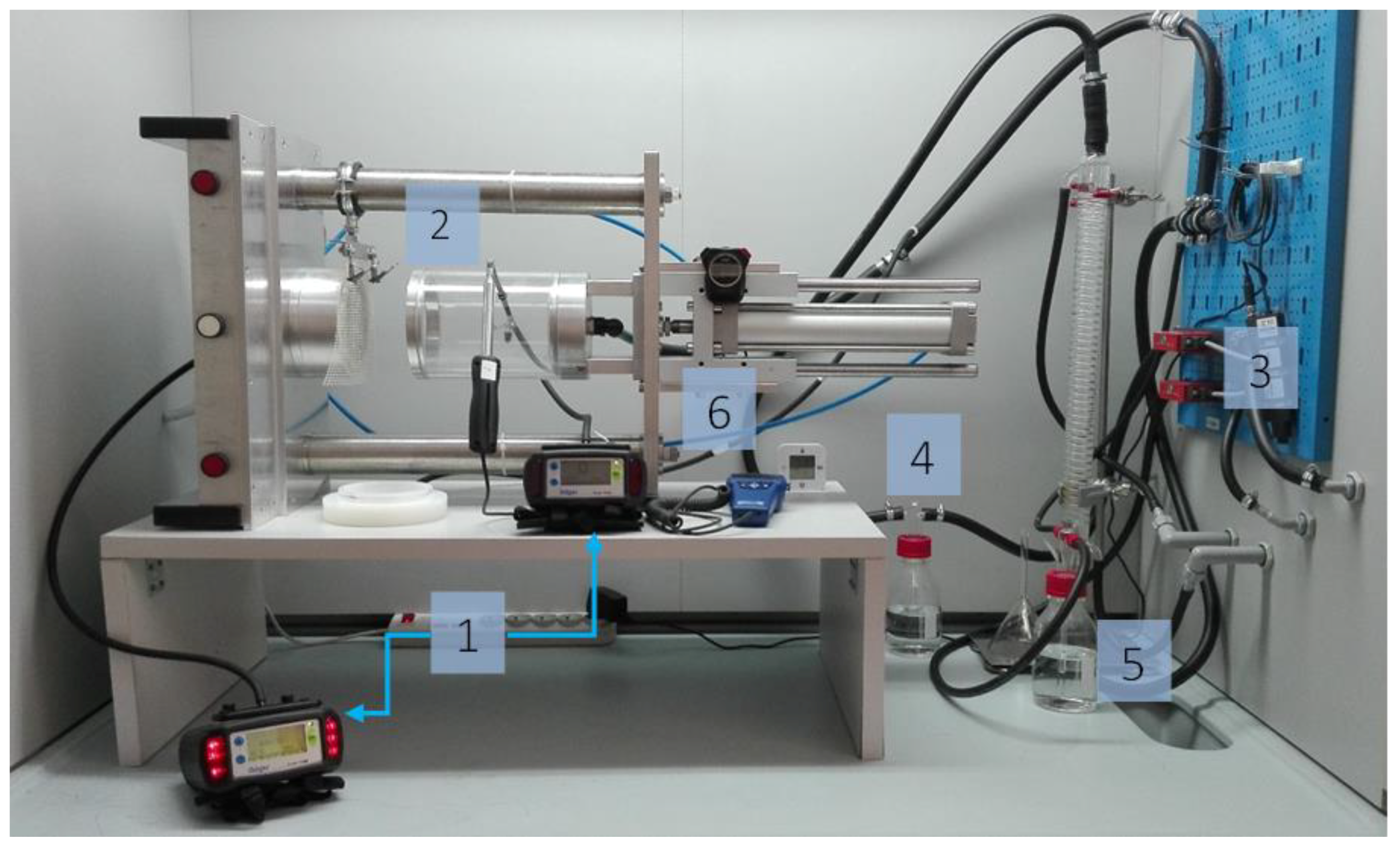
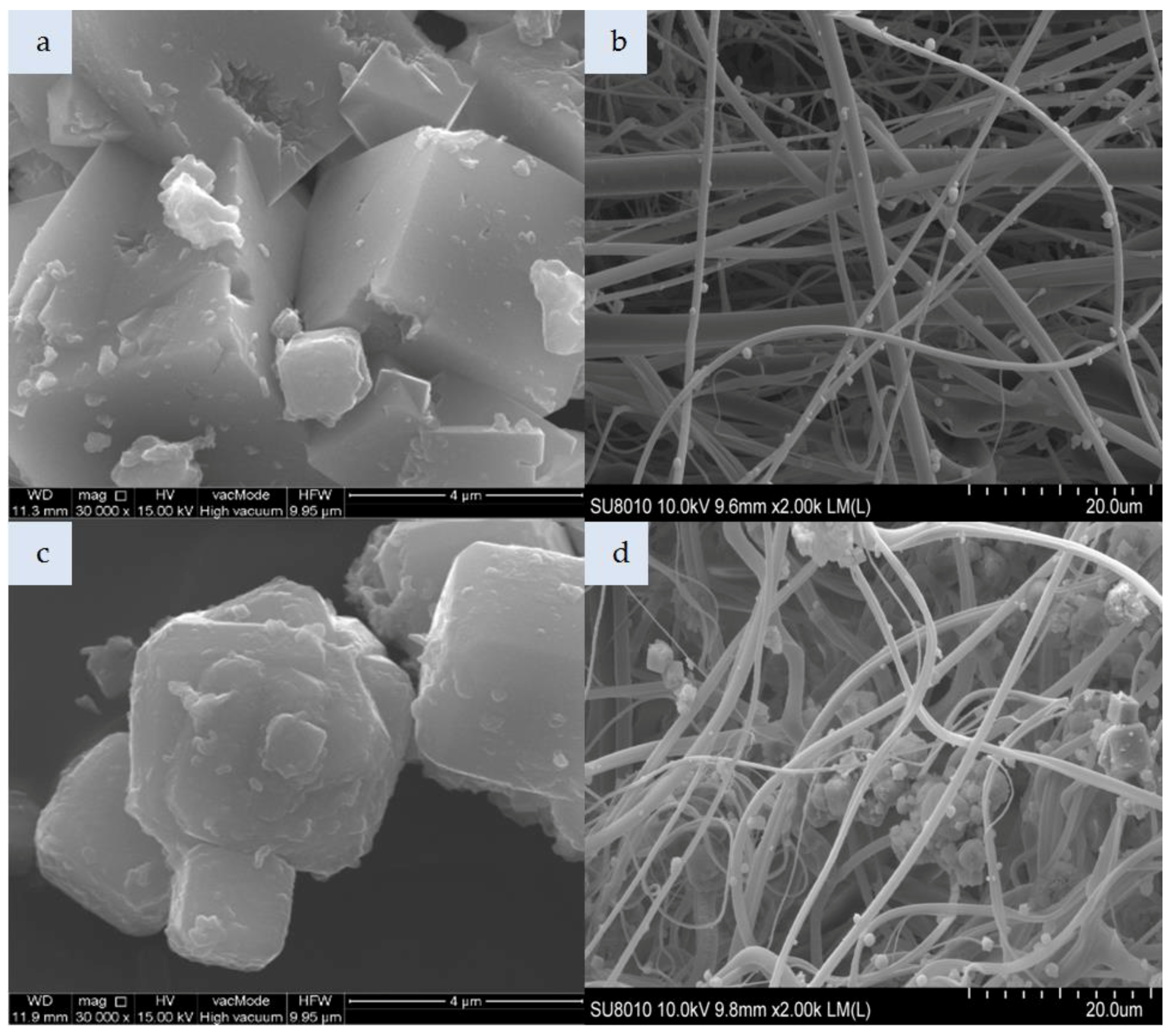
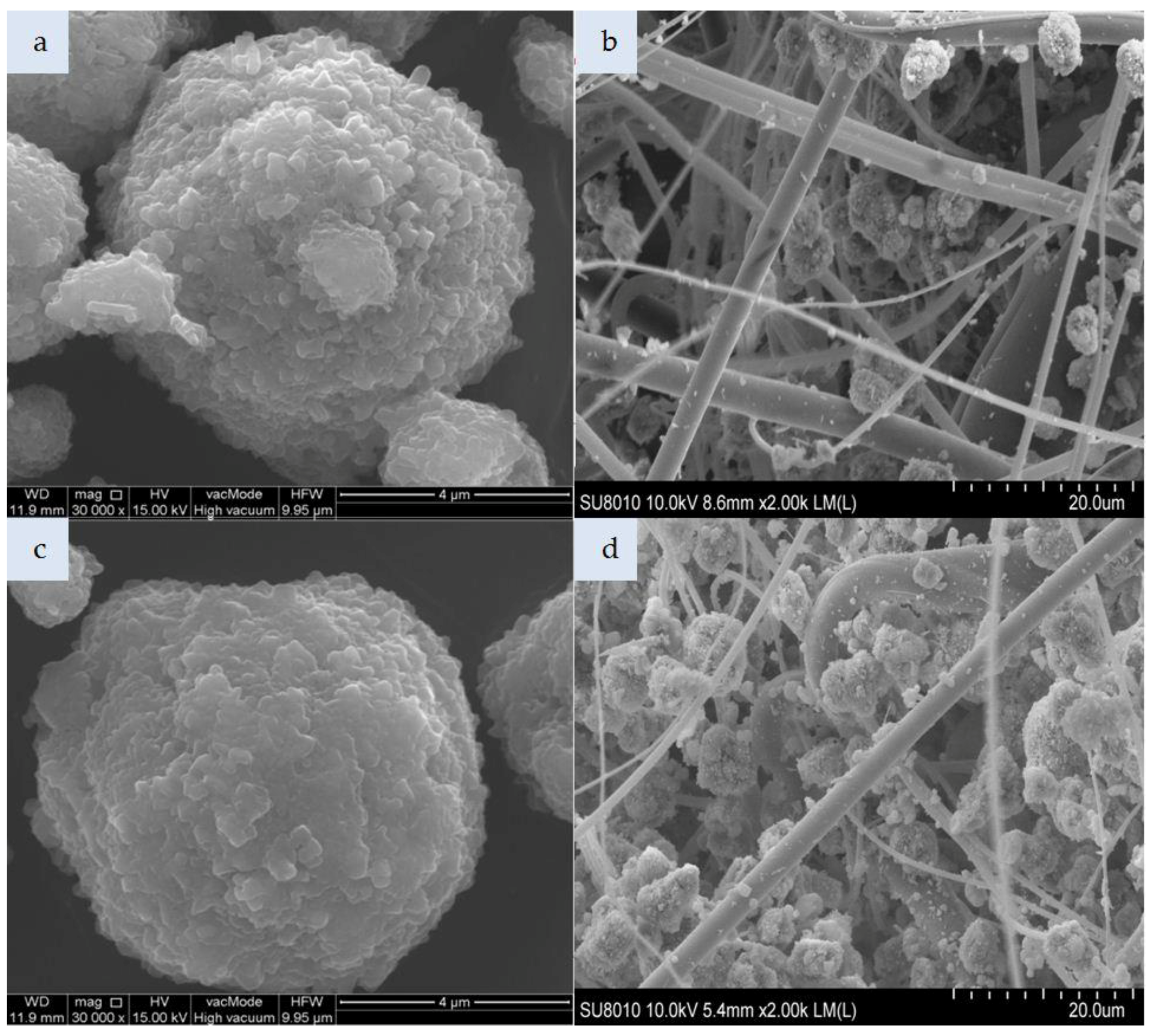
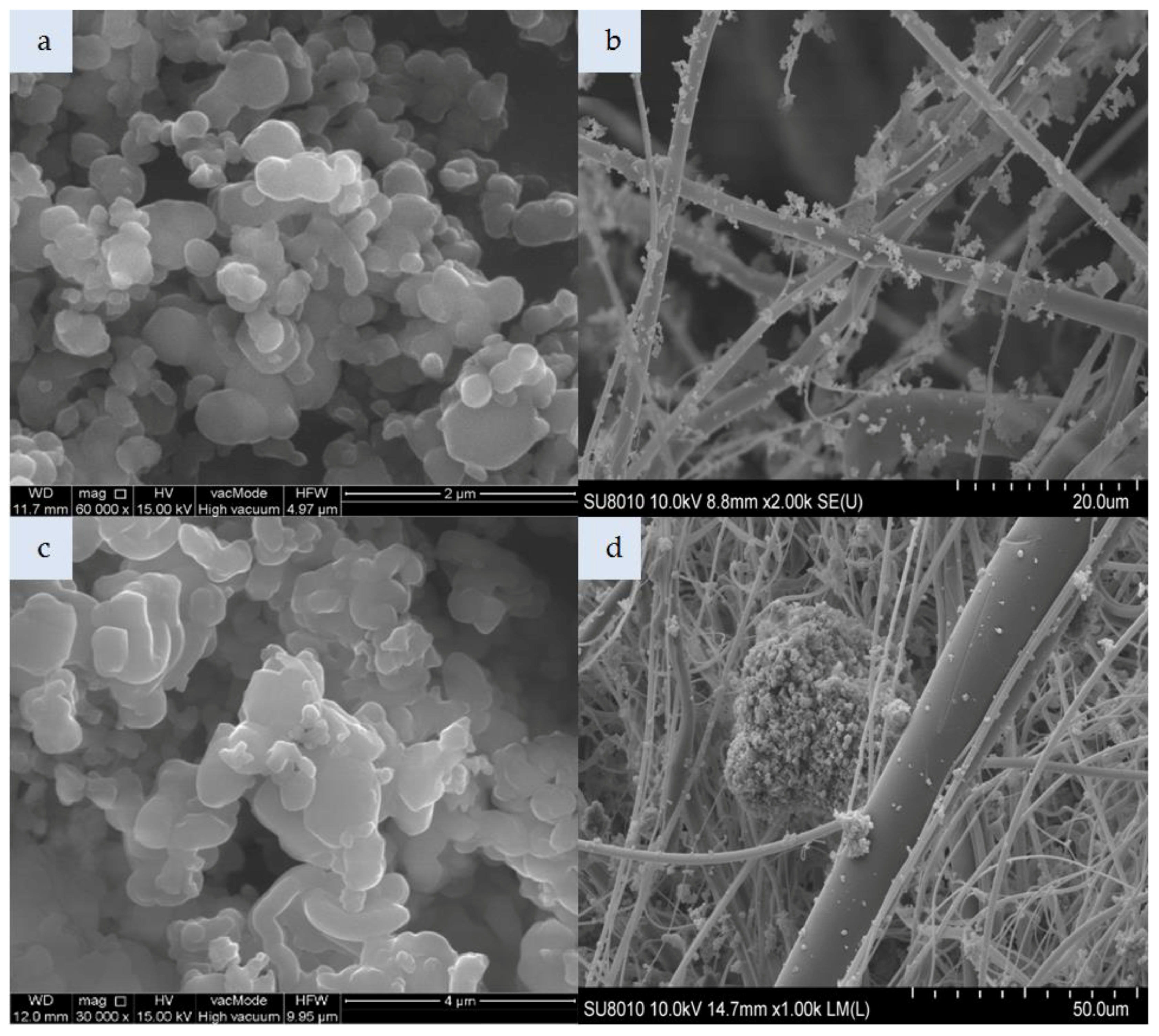

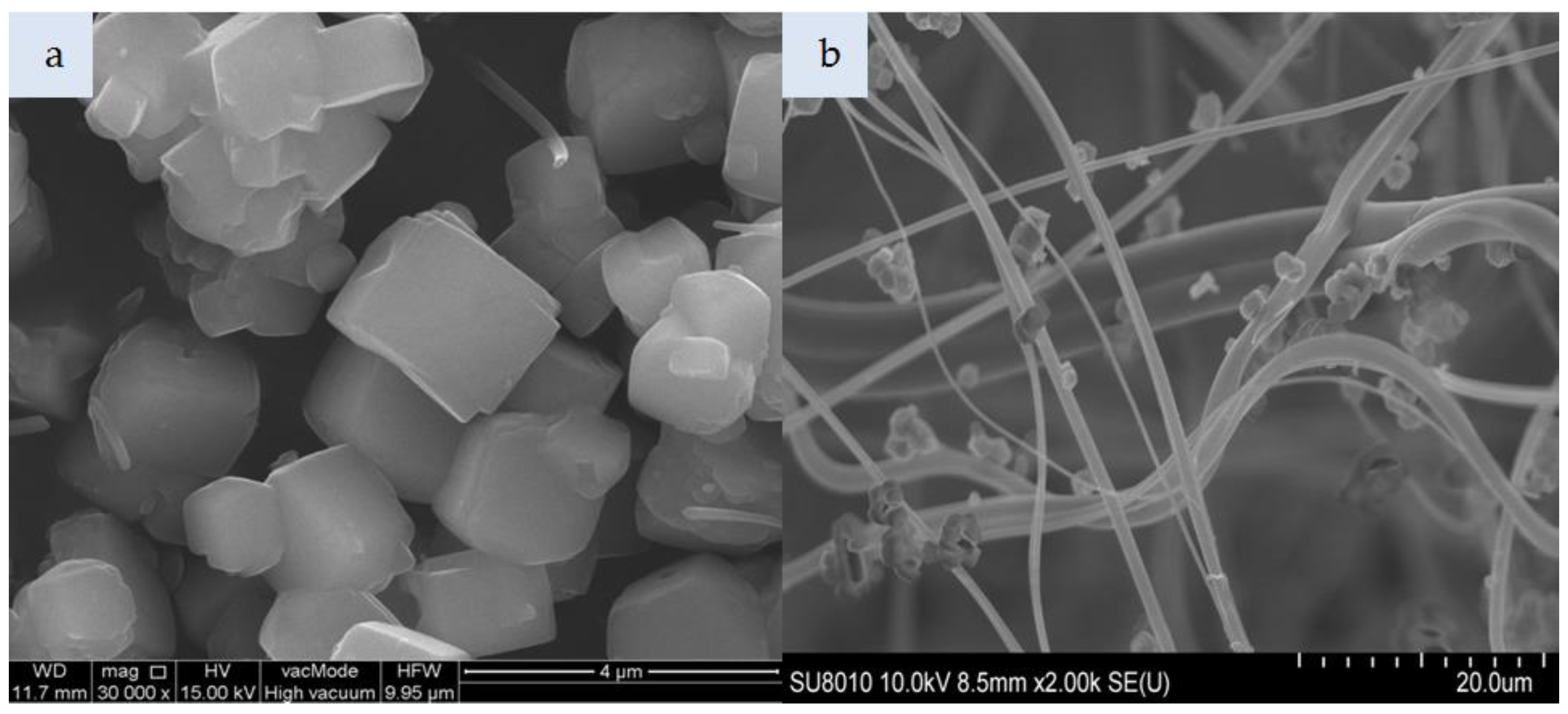
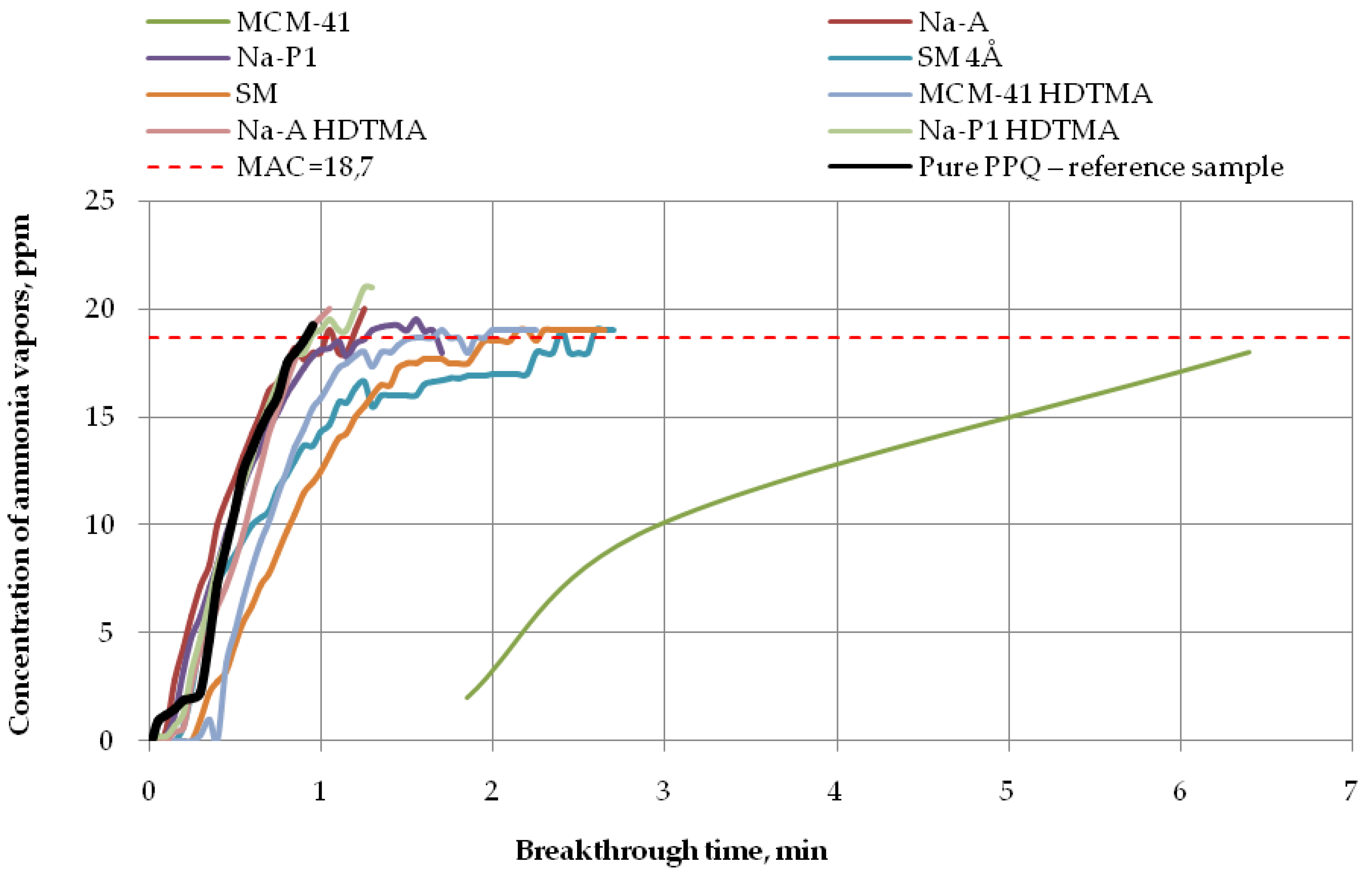

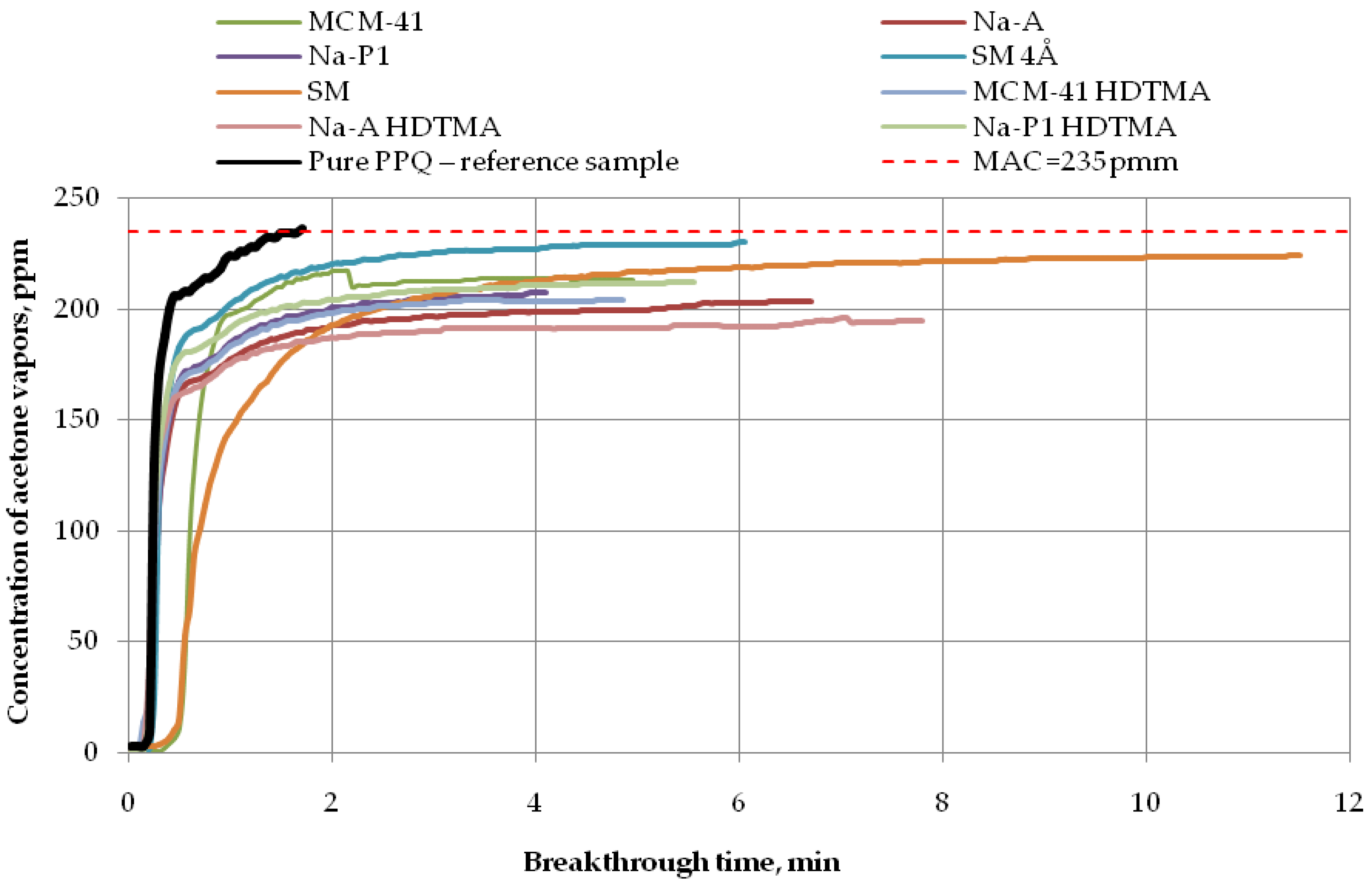
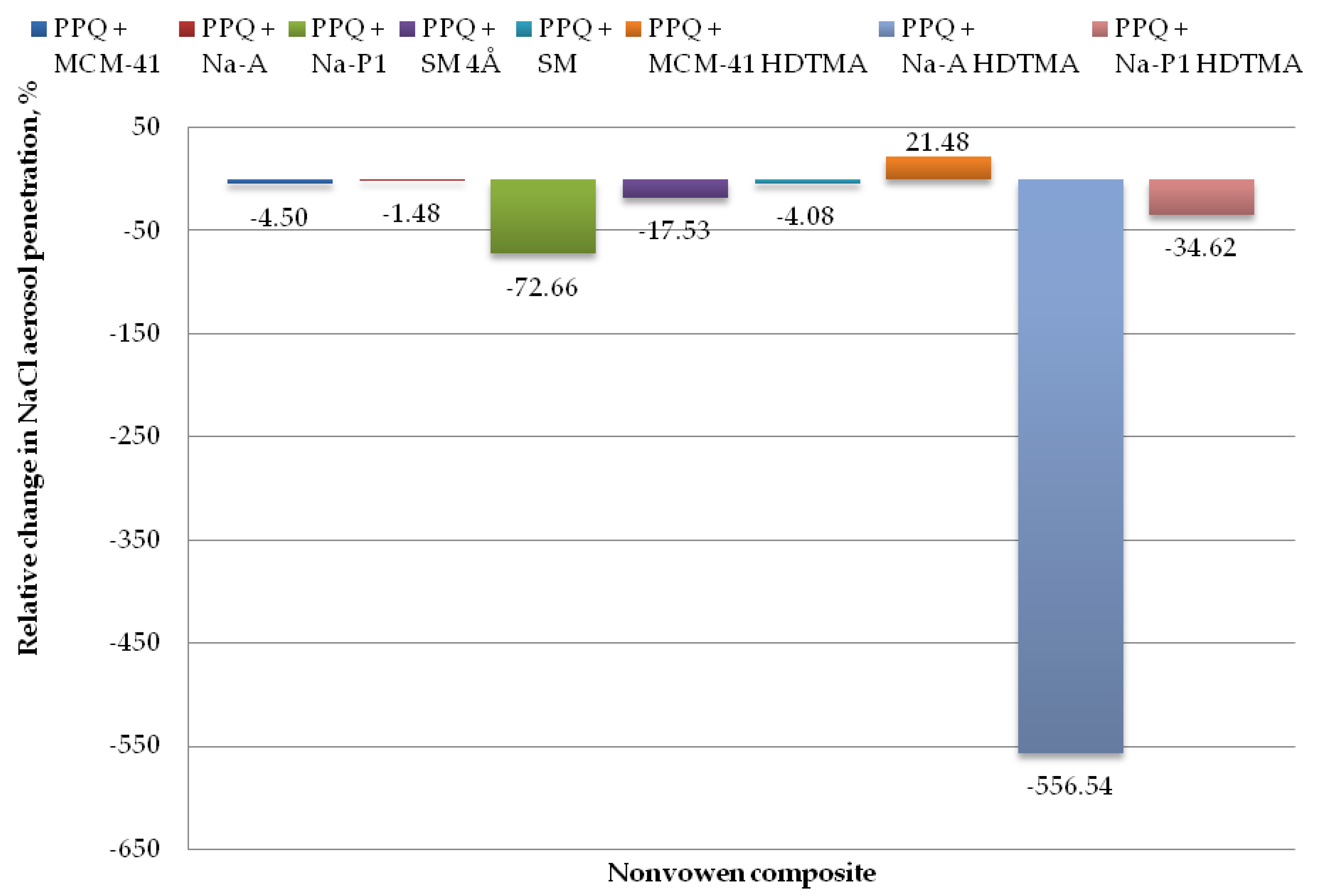
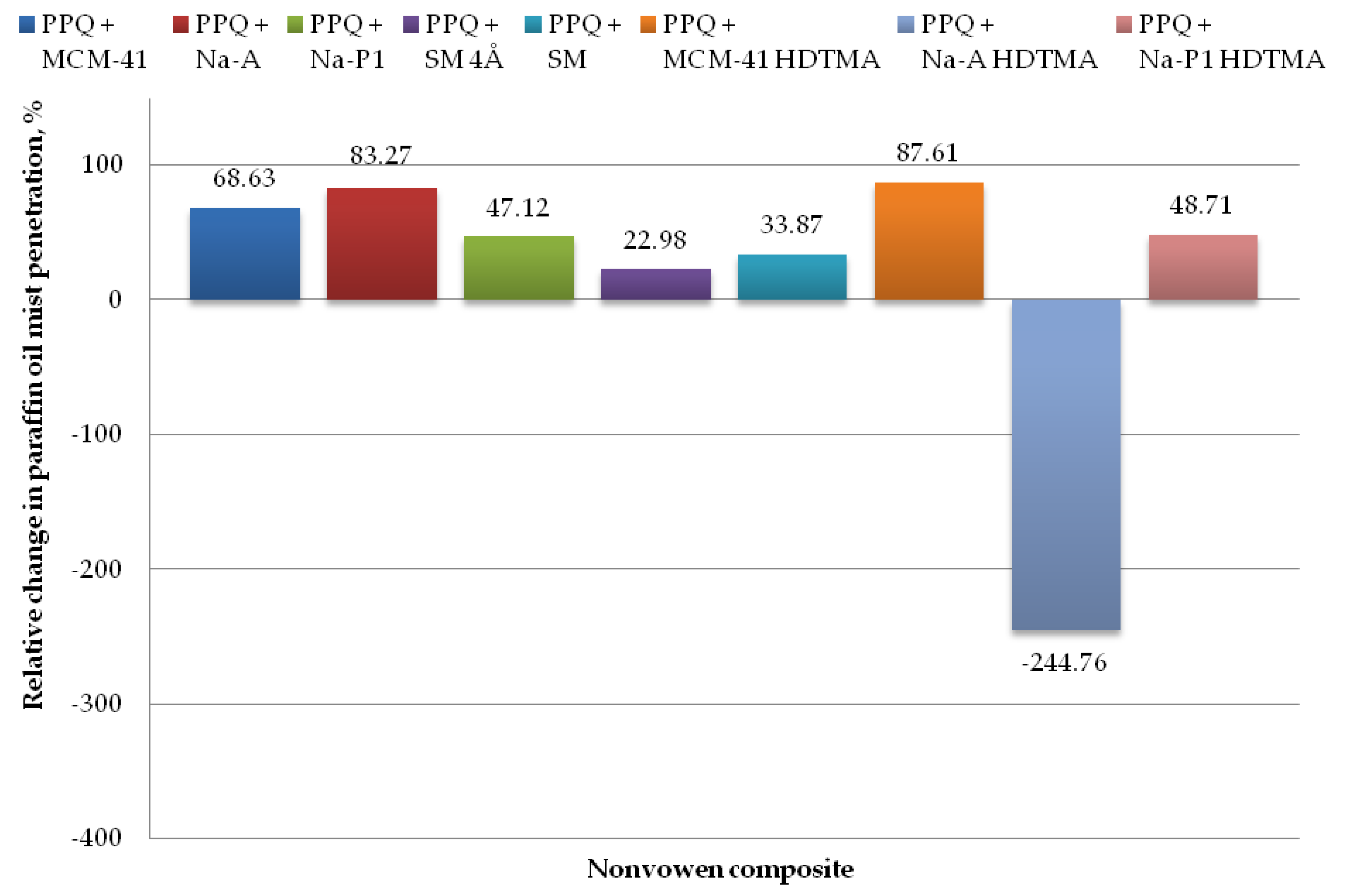

| Variant | BET Surface Area, m2/g | BJH Pore Diameter, nm | BJH Average Pore Volume, cm3/g |
|---|---|---|---|
| Zeolite Na-A | 8.52 | 5.11 | 0.013 |
| Zeolite Na-A HDTMA | 3.31 | 4.75 | 0.008 |
| Zeolite Na-P1 | 38.06 | 12.07 | 0.160 |
| Zeolite Na-P1 HDTMA | 5.03 | 3.63 | 0.006 |
| MCM-41 | 953.30 | 3.10 | 0.850 |
| MCM-41 HDTMA | 264.31 | 2.40 | 0.230 |
| Molecular sieve SM 4Å * | 3.40 | 4.50 | 0.006 |
| Molecular sieve SM ** | 325.60 | 2.21 | 0.130 |
| Variant | BET Surface Area, m2/g | Surface Density, g/m2 | Composite Thickness, mm |
|---|---|---|---|
| PPQ + Na-A | 2.80 | 202.45 | 3.48 |
| PPQ + Na-A HDTMA | 2.32 | 214.01 | 2.48 |
| PPQ + Na-P1 | 13.38 | 340.57 | 3.70 |
| PPQ + Na-P1 HDTMA | 9.77 | 343.32 | 3.94 |
| PPQ + MCM-41 | 310.70 | 134.04 | 4.14 |
| PPQ + MCM-41 HDTMA | 6.27 | 299.94 | 4.49 |
| PPQ + SM 4 Å | 1.38 | 163.36 | 3.47 |
| PPQ + SM | 111.73 | 131.72 | 4.25 |
| Type of Tested Gas | Type of Sorbent | Sorbent Code | Concetration, ppm | Partial Pressure, Pa | Capacity (C), mg g−1 | Partition Coefficient (PC), mol kg−1 Pa−1 |
|---|---|---|---|---|---|---|
| AMMONIA | Zeolite | Na-A | 18.7 | 1.87 | 0.0003 | 8.77 × 10−6 |
| Na-P1 | 1.87 | 0.0002 | 5.21 × 10−6 | |||
| SM 4A | 1.87 | 0.0008 | 2.48 × 10−5 | |||
| SM | 1.87 | 0.0013 | 4.17 × 10−5 | |||
| Na-A H | 1.87 | 0.0002 | 5.84 × 10−6 | |||
| Na-P1 H | 1.87 | 0.0001 | 3.01 × 10−6 | |||
| MSM * | MCM-41 | 1.87 | 0.0018 | 5.76 × 10−5 | ||
| MCM-41 H | 1.87 | 0.0002 | 5.41 × 10−6 | |||
| ACETONE | Zeolite | Na-A | 235 | 23.5 | 0.7267 | 5.32 × 10−4 |
| Na-P1 | 23.5 | 0.2003 | 1.47 × 10−4 | |||
| SM 4A | 23.5 | 1.1666 | 8.55 × 10−4 | |||
| SM | 23.5 | 4.0716 | 2.98 × 10−3 | |||
| Na-A H | 23.5 | 0.7321 | 5.36 × 10−4 | |||
| Na-P1 H | 23.5 | 0.2708 | 1.98 × 10−4 | |||
| MSM * | MCM-41 | 23.5 | 1.5640 | 1.15 × 10−4 | ||
| MCM-41 H | 23.5 | 0.2757 | 2.02 × 10−4 | |||
| CYKLOHEXANE | Zeolite | Na-A | 81 | 8.1 | 0.0501 | 7.34 × 10−5 |
| Na-P1 | 8.1 | 0.0146 | 2.14 × 10−5 | |||
| SM 4A | 8.1 | 0.0434 | 6.37× 10−5 | |||
| SM | 8.1 | 0.1860 | 2.73 × 10−4 | |||
| Na-A H | 8.1 | 0.0279 | 4.09 × 10−5 | |||
| Na-P1 H | 8.1 | 0.0251 | 3.69 × 10−5 | |||
| MSM * | MCM-41 | 8.1 | 0.0783 | 1.15 × 10−4 | ||
| MCM-41 H | 8.1 | 0.0267 | 3.92 × 10−5 |
| No. | Variant | Mean NaCl Aerosol Penetration, % | Standard Deviation | Median | MAX, % | MIN, % |
|---|---|---|---|---|---|---|
| 1 | PPQ + MCM-41 | 2.59 a | 0.70 | 2.34 | 3.94 | 1.89 |
| 2 | PPQ +Na-A | 2.51 a | 1.18 | 2.05 | 4.40 | 1.32 |
| 3 | PPQ + Na-P1 | 4.27 a | 1.52 | 5.12 | 6.08 | 2.01 |
| 4 | PPQ + SM 4Å | 2.91 a | 1.12 | 2.49 | 5.40 | 2.17 |
| 5 | PPQ + SM | 2.58 a | 0.34 | 2.47 | 3.31 | 2.26 |
| 6 | PPQ + MCM-41 HDTMA | 1.94 a | 0.36 | 1.95 | 2.49 | 1.45 |
| 7 | PPQ + Na-A HDTMA | 16.25 b | 7.96 | 18.30 | 24.65 | 3.74 |
| 8 | PPQ + Na-P1 HDTMA | 3.33 a | 1.62 | 2.62 | 6.92 | 2.29 |
| 9 | Pure PPQ reference sample | 2.47 | 0.26 | 2.36 | 2.93 | 2.21 |
| No. | Variant | Mean Paraffin Oil Mist Aerosol Penetration, % | Standard Deviation | Median | MAX, % | MIN, % |
|---|---|---|---|---|---|---|
| 1 | PPQ + MCM-41 | 1.30 a | 0.27 | 1.20 | 1.80 | 0.98 |
| 2 | PPQ + Na-A | 0.69 a | 0.36 | 0.80 | 1.20 | 0.59 |
| 3 | PPQ + Na-P1 | 2.19 a | 0.58 | 2.20 | 3.10 | 1.10 |
| 4 | PPQ + SM 4Å | 3.18 a | 0.19 | 3.20 | 3.40 | 2.90 |
| 5 | PPQ + SM | 2.73 a | 0.91 | 2.75 | 4.00 | 1.50 |
| 6 | PPQ + MCM-41 HDTMA | 0.51 a | 0.04 | 0.49 | 0.58 | 0.48 |
| 7 | PPQ + Na-A HDTMA | 14.25 b | 0.83 | 14.50 | 15.00 | 13.00 |
| 8 | PPQ + Na-P1 HDTMA | 2.12 a | 0.91 | 1.70 | 3.90 | 1.50 |
| 9 | Pure PPQ reference sample | 4.13 | 0.42 | 4.15 | 4.70 | 3.60 |
| No. | Variant | Mean Airflow Resistance, Pa | Standard Deviation | Median | MAX, Pa | MIN, Pa |
|---|---|---|---|---|---|---|
| 1 | PPQ + MCM-41 | 331.50 b | 14.38 | 334.50 | 348.00 | 313.00 |
| 2 | PPQ + Na-A | 648.00 d | 73.39 | 655.00 | 747.00 | 489.00 |
| 3 | PPQ + Na-P1 | 537.14 c | 40.37 | 520.00 | 590.00 | 485.00 |
| 4 | PPQ + SM 4Å | 268.00 ab | 4.69 | 266.50 | 275.00 | 261.00 |
| 5 | PPQ + SM | 283.50 ab | 34.32 | 278.50 | 338.00 | 250.00 |
| 6 | PPQ + MCM-41 HDTMA | 876.80 e | 36.42 | 851.00 | 940.00 | 848.00 |
| 7 | PPQ + Na-A HDTMA | 306.25 ab | 27.49 | 308.50 | 341.00 | 267.00 |
| 8 | PPQ + Na-P1 HDTMA | 517.40 c | 73.48 | 539.00 | 593.00 | 386.00 |
| 9 | Pure PPQ reference sample | 260.83 | 8.82 | 260.50 | 272.00 | 248.00 |
© 2019 by the authors. Licensee MDPI, Basel, Switzerland. This article is an open access article distributed under the terms and conditions of the Creative Commons Attribution (CC BY) license (http://creativecommons.org/licenses/by/4.0/).
Share and Cite
Brochocka, A.; Nowak, A.; Panek, R.; Franus, W. The Effects of Textural Parameters of Zeolite and Silica Materials on the Protective and Functional Properties of Polymeric Nonwoven Composites. Appl. Sci. 2019, 9, 515. https://doi.org/10.3390/app9030515
Brochocka A, Nowak A, Panek R, Franus W. The Effects of Textural Parameters of Zeolite and Silica Materials on the Protective and Functional Properties of Polymeric Nonwoven Composites. Applied Sciences. 2019; 9(3):515. https://doi.org/10.3390/app9030515
Chicago/Turabian StyleBrochocka, Agnieszka, Aleksandra Nowak, Rafał Panek, and Wojciech Franus. 2019. "The Effects of Textural Parameters of Zeolite and Silica Materials on the Protective and Functional Properties of Polymeric Nonwoven Composites" Applied Sciences 9, no. 3: 515. https://doi.org/10.3390/app9030515
APA StyleBrochocka, A., Nowak, A., Panek, R., & Franus, W. (2019). The Effects of Textural Parameters of Zeolite and Silica Materials on the Protective and Functional Properties of Polymeric Nonwoven Composites. Applied Sciences, 9(3), 515. https://doi.org/10.3390/app9030515







